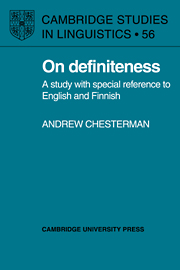Book contents
- Frontmatter
- Contents
- Acknowledgements
- 1 Introduction
- 2 English articles: the research traditions
- 3 English article usage
- 4 A unified description of the English articles
- 5 Finnish: no articles
- 6 Finnish spesies
- 7 The status of definiteness in Finnish
- 8 English and Finnish contrasted
- 9 Wider perspectives
- References
- Author index
- Subject index
7 - The status of definiteness in Finnish
Published online by Cambridge University Press: 18 September 2009
- Frontmatter
- Contents
- Acknowledgements
- 1 Introduction
- 2 English articles: the research traditions
- 3 English article usage
- 4 A unified description of the English articles
- 5 Finnish: no articles
- 6 Finnish spesies
- 7 The status of definiteness in Finnish
- 8 English and Finnish contrasted
- 9 Wider perspectives
- References
- Author index
- Subject index
Summary
Divisibility and quantity
I start by reconsidering the basic notions of divisibility and quantity in Finnish.
At first sight the divisibility distinction in Finnish appears straightforward, separating singular count nouns from plural count and mass nouns. Yet certain definiteness readings remain problematic. Because divisibility is a semantic concept many nouns can be used in both divisible and non-divisible senses, as in English: for instance kakku ‘cake’. In its divisible usage the word will allow the expression of partitive quantity, but in its non-divisible use it will not. In this latter usage, a partitive would have some other cause, not partial quantity. Recall examples such as the following:
(1) Pesimme autoa.
washed-1PL car-PART
‘We were washing the/a car.’
Auto is non-divisible, and the partitive signifies irresultative action; the definiteness of the car is determined by the context.
(2) Näimme juustoa.
saw-1PL cheese-PART
‘We saw some cheese.’
The verb is resultative and juusto is divisible: it must therefore be read as some cheese, indefinite. But now consider (3):
(3) Söimme kakkua.
ate-1PL cake-PART
Kakku can be divisible or non-divisible, so that three readings are possible (out of context, of course):
(a) Non-divisible, partitive due to irresultative verb: ‘We were eating a/the cake.’
(b) Divisible, partitive marking partial quantity; verb resultative: ‘We ate (some) cake.’
[…]
- Type
- Chapter
- Information
- On DefinitenessA Study with Special Reference to English and Finnish, pp. 133 - 161Publisher: Cambridge University PressPrint publication year: 1991



